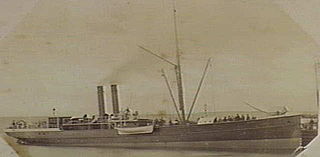
Kilkee is a small coastal town in County Clare, Ireland. It is in the parish of Kilkee, formerly Kilfearagh. Kilkee is midway between Kilrush and Doonbeg on the N67 road. The town is popular as a seaside resort. The horseshoe bay is protected from the Atlantic Ocean by the Duggerna Reef.
Several ships have been named Innisfallen, the name being derived from the island of Innisfallen in County Kerry and often given to vessels serving the southerly coasts of Ireland. Five served on the Irish Sea route between Cork and Fishguard, from 1896 onwards: two of these were war casualties whilst the remainder have been either scrapped or renamed and sold to new owners.

RMS Leinster was an Irish ship operated by the City of Dublin Steam Packet Company. She served as the Kingstown-Holyhead mailboat until she was torpedoed and sunk by the German submarine UB-123, which was under the command of Oberleutnant zur See Robert Ramm, on 10 October 1918, while bound for Holyhead. She sank just outside Dublin Bay at a point 4 nautical miles (7.4 km) east of the Kish light.

The Captayannis was a Greek sugar-carrying vessel that sank in the Firth of Clyde, Scotland in 1974.

SS Elbe was a transatlantic ocean liner built in the Govan Shipyard of John Elder & Company Ltd., Glasgow, in 1881 for the Norddeutscher Lloyd of Bremen. She foundered on the night of 30 January 1895 following a collision in the North Sea with the steamship Crathie, resulting in the loss of 334 lives.

SS Alert was a steamship that sank off Cape Schanck, Victoria, Australia on 28 December 1893. The ship was built for the gentle waters of Scottish lochs and was almost 51 m (167 ft) long and weighed 247 tonnes.

SS Utopia was a transatlantic passenger steamship built in 1874 by Robert Duncan & Co of Glasgow. From 1874 to 1882 she operated on Anchor Line routes from Glasgow to New York City, from Glasgow to Bombay and from London to New York City. After 1882 she carried Italian immigrants to the United States.
The Edmond was a chartered passenger sailing vessel that sank off the coast of Kilkee, County Clare on 19 November 1850. It was built in 1833 in Granville, Nova Scotia, a small community near Annapolis Royal, a town that became famous for wooden shipbuilding during the 1800s. At the time of the disaster it was owned by John Arnott and George Cannock, who co-owned the Arnotts department store. Today there is a commemorative plaque engraved on the sea wall just beside the wreck site, in an area now known as Edmond Point.
The Fulmar was a cargo vessel that sank in the Atlantic Ocean off Kilkee, County Clare, Ireland, on the night of 30 January 1886. At the time of the disaster the ship was transporting coal from Troon in Ayrshire, Scotland to Limerick city in Ireland. Occurring 50 years to the day of the sinking of the Intrinsic, the ship is one of four that have perished with loss of life off the coast of the small town of Kilkee, the others being the Edmond, and the Inishtrahull.

SS Oceana was a P&O passenger liner and cargo vessel, launched in 1887 by Harland and Wolff of Belfast and completed in 1888. Originally assigned to carry passengers and mail between London and Australia, she was later assigned to routes between London and British India. On 16 March 1912 the ship collided in the Strait of Dover with the Pisagua, a 2,850 GRT German-registered four-masted steel-hulled barque. As a result Oceana sank off Beachy Head on the East Sussex coast, with the loss of 17 lives.
The following index is provided as an overview of and topical guide to Wikipedia's articles on recreational dive sites. The level of coverage may vary:

Recreational dive sites are specific places that recreational scuba divers go to enjoy the underwater environment or for training purposes. They include technical diving sites beyond the range generally accepted for recreational diving. In this context all diving done for recreational purposes is included. Professional diving tends to be done where the job is, and with the exception of diver training and leading groups of recreational divers, does not generally occur at specific sites chosen for their easy access, pleasant conditions or interesting features.

SS Russia was an iron-hulled American Great Lakes package freighter that sank in a Lake Huron gale on April 30, 1909, near DeTour Village, Michigan, with all 22 of her crew and one passenger surviving.








